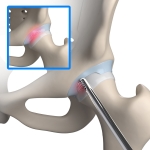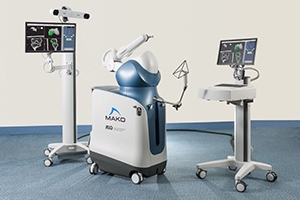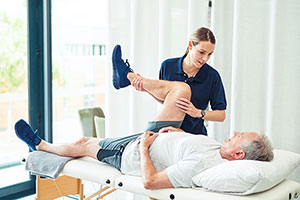No matter your lifestyle, profession or activity level, pain in your hip as you walk or run can keep you from doing the things you love and negatively impact your quality of life. Having stiffness in the hip and a limited range of motion are just some of the many symptoms you may experience due to labral tears.
A hip labral tear is a condition wherein the protective layer of cartilage called the labrum becomes injured. This cartilage ring on your hip joint’s socket plays the crucial role of keeping the top of your femur aligned with the pelvis’s acetabulum as you move. It also provides cushioning and lubrication for these bones to ensure a full, frictionless range of motion.
Trauma to the hip, chronic overuse or anatomical abnormalities can all cause hip labral tears. Fortunately, procedures like labral debridement can address this condition and allow you to return to your sport, occupation or daily activities.
What Is Labral Debridement?
Labral debridement is a minimally invasive surgery performed to trim the torn or weakened areas of the labrum that can get caught in the joint and cause further complications. It works best for smaller yet highly macerated tears and older patients looking for non-extensive surgical options.
Labral Debridement vs. Labral Repair
Both labral debridement and labral repair procedures have produced high success rates in addressing hip conditions, reducing pain and improving the joint’s range of motion.
However, the main difference is that the former is less extensive than the latter. Labral repair often involves making large incisions to implant anchors into the bone or reattach the torn labrum to the socket and ultimately reverse the damage. On the other hand, labral debridement only shaves off loose portions of the labrum, so no fixation devices are used.
While labral debridement seems to be easier, determining the most suitable procedure for your case will still depend on factors such as the extent of the damage.
SLAP Tears and Superior Labral Debridement
While searching online for “what is labral debridement” and other frequently asked questions, you might also come across debridement for SLAP tears. Short for Superior Labrum Anterior and Posterior, a SLAP tear is an injury to the top part (superior) of the shoulder joint’s labrum extending in a curve from your chest (anterior) to the back (posterior).
Debridement of the SLAP tear helps treat minor injuries that do not involve the tendon in the biceps. Like in hip labral debridement, surgeons shave away the damaged portion of the labrum to leave a smooth edge behind and alleviate symptoms.
Hip Labral Tear Treatment Options
Hip labral tears don’t always require surgical interventions. Usually, surgeons recommend nonsurgical treatments first to relieve your pain and address the tear. These may include:
- Rest
- Activity or lifestyle modification
- Over-the-counter medications for pain and inflammation
- Steroid and anesthetic injections
- Physical therapy
If you have a severe hip labral tear or the pain persists after these options, your doctor may advise you to undergo surgery. As overwhelming as this sounds, the good news is that labral debridement is often performed arthroscopically.
Arthroscopic Labral Debridement
Arthroscopic labral debridement is a minimally invasive procedure using small incisions and special tools to locate and address the labral tear.
In this surgery, the surgeon makes a button-hole-sized incision near the hip to insert a small, fiber-optic tube with a camera called an arthroscope. This device gives the surgeon a clear view of the joint throughout the procedure. Then, two or three more tiny cuts will be made to insert the surgical tools.
A motorized shaver is often used to shave torn tissue. But in cases of smaller tears, an electrothermal flex probe may be used instead to melt the torn tissue and leave behind the intact labrum.
Most of the time, the entire procedure is completed within an hour. Once the debridement is complete, the incisions will be closed with sutures, and you will be allowed to go home the same day.
Postoperative Care
Arthroscopic labral debridement is usually performed as an outpatient procedure, which means you can be discharged once it’s done. However, while you can resume walking almost immediately, getting physical therapy is necessary to help you restore the joint’s strength and range of motion.
You may also be recommended to take antibiotics to prevent infections, along with certain medications to reduce pain and inflammation. In addition, your doctor may advise you to use crutches for 1 to 3 weeks until you can support weight on the leg that was operated on.
If your job, sport or daily activities require you to work your hip, it’s always a good idea to work with physical therapists. They can guide you through your recovery period so you can ease back into your routine safely and quickly.
How To Know If Hip Labral Debridement Was A Success
Soreness in the hip that was operated on is expected during the first few weeks, so don’t be discouraged if the site takes some time to heal. Generally, you will need three months to completely recover before you can begin demanding activities again, whether it be prolonged walking, heavy lifting or squatting.
With that in mind, know that there’s no single recovery timeline for every patient. Your physical therapist will consider your previous symptoms, operation findings and your own recovery progress to create the most suitable rehabilitation timeline for you.
Diligently attending your physical therapy sessions and adhering to the advice of your physical therapist can help you walk free of pain within the first two months after surgery. However, note that it could take you no less than three months to return to your original fitness activity levels.
Lastly, failures may still occur despite the success of arthroscopic procedures in general. Factors such as your hip & spine relationship, the surgeon’s expertise and the postoperative physical therapy can impact the results of your surgery.
If you have been experiencing unexplained and persistent postoperative pain or stiffness, let your physician know as soon as possible.
Consult With the Experts To Make the Best Comeback
Since your hip’s labrum helps maintain joint stability, lubrication and shock absorption, labral tears cause pain and hinder you from performing your best at work or on the court. Fortunately, minor tears can be addressed with minimally invasive procedures like labral debridement before they lead to further complications.
However, there are still risks involved in arthroscopic procedures, as with any surgical interventions. To get the best results and gain peace of mind, it’s always a good idea to consult with the expert hip orthopedic surgeons at the American Hip Institute. Noted pioneers in hip arthroscopy, we deliver safe and innovative treatments to help you recover from your hip injury.
For more information on hip arthroscopy, contact us to request an appointment. You may also visit our blog for helpful resources on hip conditions and available treatment options.




